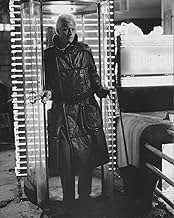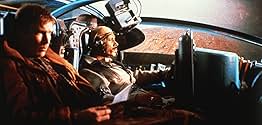Un agent d'une unité spéciale, un blade runner, doit poursuivre et éliminer les quatre répliquant qui ont volé un navire dans l'espace et sont retournés sur Terre pour trouver leur créateur.Un agent d'une unité spéciale, un blade runner, doit poursuivre et éliminer les quatre répliquant qui ont volé un navire dans l'espace et sont retournés sur Terre pour trouver leur créateur.Un agent d'une unité spéciale, un blade runner, doit poursuivre et éliminer les quatre répliquant qui ont volé un navire dans l'espace et sont retournés sur Terre pour trouver leur créateur.
- Nommé pour 2 oscars
- 13 victoires et 22 nominations au total
Bob Okazaki
- Sushi Master
- (as Robert Okazaki)
Remembering Rutger Hauer (1944-2019)
Remembering Rutger Hauer (1944-2019)
We celebrate the life and legacy of Rutger Hauer, the award-winning actor best known for Blade Runner and The Hitcher.
Histoire
Le saviez-vous
- AnecdotesDirector Sir Ridley Scott regards this movie as probably his most personal and complete movie.
- Gaffes(at around 9 mins) When we see Deckard waiting for his noodles, he is reading that day's newspaper. Later in Leon's apartment (at around 25 mins), the same newspaper is seen in one of the drawers, except it is old and soiled, as if it has been there for years. We know they are the same since both newspapers have the same headline about farming on the moon.
- Générique farfeluIn the "happy ending" Theatrical/International cuts, the credits play over the gorgeous scenery. In later Director/Final cuts, they play over a normal black background.
- Autres versionsAll U.S video tape releases before January 1993 are the unrated version and contain the extra violence in the Euro-release that's not seen in the 117 minute American theatrical release:
- When Roy attacks Tyrell we clearly see him pushing his thumbs into Tyrell's eyes, and blood spurting out
- When Pris (Daryl Hannah) attacks Deckard, she reaches down and grabs him by the nostrils
- When Deckard shoots Pris, he shoots 3 times instead of 2
- When Roy pushes the nail through his hand, there is a shot of the nail coming through the skin on the other side.
- ConnexionsEdited into 5 Second Movies: Blade Runner (2009)
- Bandes originalesHarps of the Ancient Temples
Composed by Gail Laughton
Performed by Gail Laughton
Courtesy of Laurel Records
Commentaire en vedette
Rick Deckard is given an assignment to 'retire' several biologically engineered fugitives.
The plot follows Deckard as he hunts replicants, falls in love and questions his own humanity. It moves slow, allowing you to take in all the sights and sounds of 2019 Los Angeles (as imagined in 1982), whilst pondering some of its themes.
The imagery and dialogue associated with what defines a sentient being and what makes us human is compellingly portrayed. The device used to explore these themes is the genetically engineered humanoid life-form, the godlike status of its creator and the morally compromised nature of the ordinary human. Additionally the number of references to the eyes and linking of what we see and remember versus what is fake and reality, is cleverly mixed into the story. If you want in depth analysis, google 'Blade Runner Themes and Motifs'.
The character of Roy Batty has been interpreted as both a religious and philosophical allegory, but these theories are debatable. He is for me the most intriguing character in the movie and his final scene is one of the most memorable of all time. Along with Deckard, it made me wonder if there is any real difference between humans and replicants. He is portrayed wonderfully by Rutger Hauer who both looks and acts the part.
Deckard is impressively played by Harrison Ford, who is perfect for movies with an emphasis on visuals. Ninety percent of his power as an actor comes from his screen presence and soulful facial expressions. His scenes with Sean Young young are as touching as the action scenes are brutal.
One of Blade Runner's most memorable aspects is its depiction of 2019 Los Angeles, with its permanently dark rainy skies, overcrowding, neon lights, high concept technology, urban decay and environmental devastation. Take away the flying cars and off-world colonies and it's not far off an accurate prediction.
I could write about the atmospheric cinematography, artistic designs and special effects, but nothing I can say would do it justice.
The question of whether Deckard is replicant or human is interesting. There is evidence of both but you must watch and decide. Does it matter? Probably not. If I had to decide, I'd say replicant.
The plot follows Deckard as he hunts replicants, falls in love and questions his own humanity. It moves slow, allowing you to take in all the sights and sounds of 2019 Los Angeles (as imagined in 1982), whilst pondering some of its themes.
The imagery and dialogue associated with what defines a sentient being and what makes us human is compellingly portrayed. The device used to explore these themes is the genetically engineered humanoid life-form, the godlike status of its creator and the morally compromised nature of the ordinary human. Additionally the number of references to the eyes and linking of what we see and remember versus what is fake and reality, is cleverly mixed into the story. If you want in depth analysis, google 'Blade Runner Themes and Motifs'.
The character of Roy Batty has been interpreted as both a religious and philosophical allegory, but these theories are debatable. He is for me the most intriguing character in the movie and his final scene is one of the most memorable of all time. Along with Deckard, it made me wonder if there is any real difference between humans and replicants. He is portrayed wonderfully by Rutger Hauer who both looks and acts the part.
Deckard is impressively played by Harrison Ford, who is perfect for movies with an emphasis on visuals. Ninety percent of his power as an actor comes from his screen presence and soulful facial expressions. His scenes with Sean Young young are as touching as the action scenes are brutal.
One of Blade Runner's most memorable aspects is its depiction of 2019 Los Angeles, with its permanently dark rainy skies, overcrowding, neon lights, high concept technology, urban decay and environmental devastation. Take away the flying cars and off-world colonies and it's not far off an accurate prediction.
I could write about the atmospheric cinematography, artistic designs and special effects, but nothing I can say would do it justice.
The question of whether Deckard is replicant or human is interesting. There is evidence of both but you must watch and decide. Does it matter? Probably not. If I had to decide, I'd say replicant.
- snoozejonc
- 17 févr. 2021
- Lien permanent
Meilleurs choix
Connectez-vous pour évaluer et surveiller les recommandations personnalisées
Détails
- Date de sortie
- Pays d’origine
- Site officiel
- Langues
- Aussi connu sous le nom de
- Dangerous Days
- Lieux de tournage
- sociétés de production
- Consultez plus de crédits d'entreprise sur IMDbPro
Box-office
- Budget
- 28 000 000 $ US (estimation)
- Brut – États-Unis et Canada
- 32 914 489 $ US
- Fin de semaine d'ouverture – États-Unis et Canada
- 6 150 002 $ US
- 27 juin 1982
- Brut – à l'échelle mondiale
- 41 758 452 $ US
- Durée1 heure 57 minutes
- Couleur
- Mixage
- Rapport de forme
- 2.39 : 1
Contribuer à cette page
Suggérer une modification ou ajouter du contenu manquant






























